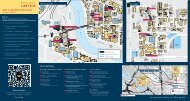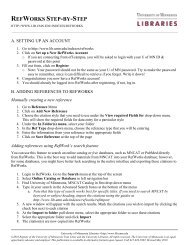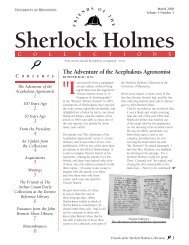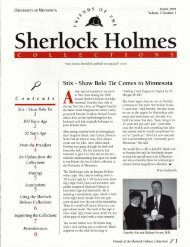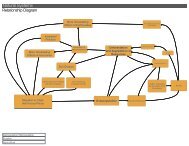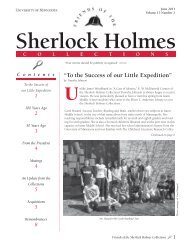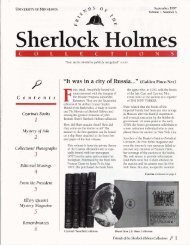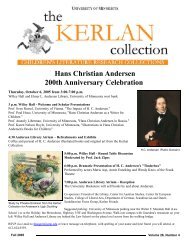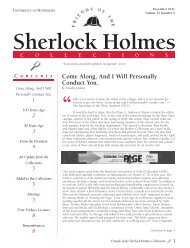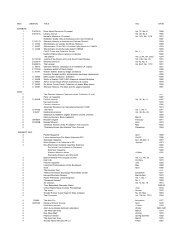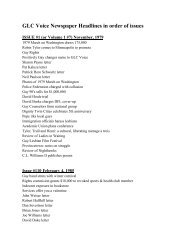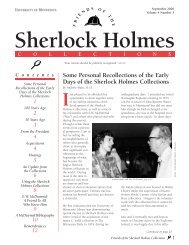Victorian Secrets and Edwardian Enigmas - University of Minnesota ...
Victorian Secrets and Edwardian Enigmas - University of Minnesota ...
Victorian Secrets and Edwardian Enigmas - University of Minnesota ...
You also want an ePaper? Increase the reach of your titles
YUMPU automatically turns print PDFs into web optimized ePapers that Google loves.
The <strong>University</strong> <strong>of</strong> <strong>Minnesota</strong> Libr aries<br />
present<br />
<strong>Victorian</strong> <strong>Secrets</strong> <strong>and</strong><br />
<strong>Edwardian</strong> <strong>Enigmas</strong>:<br />
The Riddles <strong>of</strong> the<br />
Rooms <strong>of</strong> 221B Baker Street<br />
A n E x h i b i t i o n o f M a t e r i a l s f r o m<br />
t h e S h e r l o c k H o l m e s C o l l e c t i o n s<br />
Elmer L. Andersen Libr ary,<br />
<strong>University</strong> <strong>of</strong> <strong>Minnesota</strong><br />
June 11 – Augus t 20, 2007
THE COLLECTIONS<br />
T<br />
he<br />
Sherlock Holmes Collections at the <strong>University</strong> <strong>of</strong> <strong>Minnesota</strong><br />
Libraries constitute the world’s largest gathering <strong>of</strong> material related<br />
to Sherlock Holmes <strong>and</strong> his creator Sir Arthur Conan Doyle. The Collections<br />
consist <strong>of</strong> over 15,000 items including books, journals, <strong>and</strong> a wide variety <strong>of</strong><br />
other items. The Holmes Collections are part <strong>of</strong> the Special Collections <strong>and</strong><br />
Rare Books unit <strong>of</strong> the <strong>University</strong> <strong>of</strong> <strong>Minnesota</strong> Libraries.<br />
The Sherlock Holmes Collections began in 1974 with the purchase <strong>of</strong> James C.<br />
Iraldi’s library <strong>of</strong> first editions. In 1978, Philip S. Hench, a Mayo Clinic consulting<br />
physician <strong>and</strong> recipient <strong>of</strong> the Nobel Prize for medicine (1950), <strong>and</strong> his wife<br />
Mary Kahler Hench, built one <strong>of</strong> the more remarkable Sherlockian libraries.<br />
It consists <strong>of</strong> approximately 1,800 books <strong>and</strong> 1,500 issues <strong>of</strong> periodicals, as<br />
well as unique material related to Sir Arthur Conan Doyle; William Gillette,<br />
the famous portrayer <strong>of</strong> Holmes on the stage; <strong>and</strong> Frederic Dorr Steele, the<br />
preeminent American illustrator <strong>of</strong> the adventures. The Hench collection has<br />
been a magnet for other gifts, such as the Frederic Dorr Steele Memorial<br />
Collection in 1986, <strong>and</strong> Edith Meiser’s scripts <strong>and</strong> broadcast recordings in<br />
1987. The library <strong>and</strong> papers <strong>of</strong> the late Vincent Starrett were purchased<br />
in 1988. Starrett was a prolific author <strong>and</strong> journalist, a notable bibliophile,<br />
<strong>and</strong> a celebrated Sherlockian. The Howard Haycraft collection, consisting <strong>of</strong><br />
his working library <strong>and</strong> papers, came to the <strong>University</strong> by bequest in 1992.<br />
Haycraft wrote Murder for Pleasure <strong>and</strong> edited The Art <strong>of</strong> the Mystery Story,<br />
the first comprehensive history <strong>and</strong> analysis <strong>of</strong> the detective story. John<br />
Bennett Shaw, <strong>of</strong> Santa Fe, New Mexico, built the largest collection in the<br />
world relating to Sherlock Holmes. He began collecting in 1937, at the age<br />
<strong>of</strong> twenty-three, <strong>and</strong> collected vigorously until his death in 1994. His library,<br />
acquired by the <strong>University</strong> in 1993, holds around 9,000 books; thous<strong>and</strong>s <strong>of</strong><br />
magazines; photographs, films, recordings, <strong>and</strong> tapes; art <strong>and</strong> craft works;<br />
toys <strong>and</strong> games; articles <strong>of</strong> clothing; <strong>and</strong> other ephemera. A number <strong>of</strong> other<br />
collections <strong>and</strong> assemblages <strong>of</strong> Sherlockiana have been (<strong>and</strong> continue to be)<br />
received by the Libraries.<br />
©2007 Regents <strong>of</strong> the <strong>University</strong> <strong>of</strong> <strong>Minnesota</strong>. All rights reserved.<br />
The <strong>University</strong> <strong>of</strong> <strong>Minnesota</strong> is an equal opportunity educator <strong>and</strong> employer.<br />
To request this information in alternative formats, or for disability accommodations, please contact Tim Johnson<br />
(612) 624-3552.
The <strong>University</strong> <strong>of</strong> <strong>Minnesota</strong> Libr aries<br />
present<br />
<strong>Victorian</strong> <strong>Secrets</strong> <strong>and</strong> <strong>Edwardian</strong> <strong>Enigmas</strong>:<br />
The Riddles <strong>of</strong> the Rooms <strong>of</strong> 221B Baker Street<br />
An Exhibition <strong>of</strong> Materials from<br />
the Sherlock Holmes Collections<br />
Elmer L. Andersen Libr ary,<br />
<strong>University</strong> <strong>of</strong> <strong>Minnesota</strong><br />
June 11 – Augus t 20, 2007<br />
PROJECT PERSONNEL<br />
Curator: Timothy J. Johnson<br />
Exhibit Design: Darren Terpstra<br />
Communications Director: Christopher James<br />
Graphic Design: Susan Gangl<br />
p. <br />
<strong>Victorian</strong> <strong>Secrets</strong>
Life in London <strong>and</strong> the Origins <strong>of</strong> 221B<br />
A man’s first residence in London is a revolution in his life <strong>and</strong> feelings.<br />
He loses at once no small part <strong>of</strong> his individuality. He was a<br />
man before, now he is a “party.” No longer known as Mr. Brown,<br />
but as (say) No. XXI, he feels as one <strong>of</strong> many cogs in one <strong>of</strong> the<br />
many wheels <strong>of</strong> an incessantly wearing, tearing, grinding, system<br />
<strong>of</strong> machinery. His country notions must be modified, <strong>and</strong> all his<br />
life-long ways <strong>and</strong> takings-for-granted prove crude <strong>and</strong> questionable.<br />
He is hourly reminded “This is not the way in London; that<br />
this won’t work here,” or, “people always expect,” <strong>and</strong> “you’ll<br />
soon find the difference.” Custom rules everything, <strong>and</strong> custom<br />
never before seemed to him half as strange, strong, or inexorable.<br />
1<br />
So begins an anonymous account on London life in the 1870s, published the<br />
year before James Hamish Watson matriculated at the <strong>University</strong> <strong>of</strong> London <strong>and</strong><br />
began work in St. Bartholomew’s Hospital. 2 Nine years later Watson was back<br />
in London, his “health irretrievably ruined” by wound <strong>and</strong> fever—the result <strong>of</strong><br />
his military sojourn on the sub-continent—facing his own revolution <strong>of</strong> life <strong>and</strong><br />
feelings. 3 He relates that<br />
I had neither kith nor kin in Engl<strong>and</strong>, <strong>and</strong> was therefore<br />
as free as air—or as free as an income <strong>of</strong> eleven shillings<br />
<strong>and</strong> sixpence a day will permit a man to be. Under such<br />
circumstances I naturally gravitated to London, that great<br />
cesspool into which all the loungers <strong>and</strong> idlers <strong>of</strong> the Empire<br />
are irresistibly drained. There I stayed for some time at<br />
a private hotel in the Str<strong>and</strong>, leading a comfortless, meaningless<br />
existence, <strong>and</strong> spending such money as I had, considerably<br />
more freely than I ought. 4<br />
This twenty-eight-year-old doctor’s “comfortless, meaningless<br />
existence” threatened to crush him beneath “the many wheels<br />
<strong>of</strong> an incessantly wearing, tearing, grinding, system <strong>of</strong> machinery.”<br />
“In London,” our anonymous chronicler wrote, “man rubs<br />
out, elsewhere he rusts out. No doubt the mental stimulus <strong>of</strong><br />
Illustration from A Case <strong>of</strong><br />
London staves <strong>of</strong>f much disease, for idle men eat themselves to<br />
Identity by Sidney Paget<br />
death <strong>and</strong> worry themselves to death.” 5 Watson, aware <strong>of</strong> the<br />
threat, “soon realized that I must either leave the metropolis <strong>and</strong><br />
rusticate somewhere in the country, or that I must make a complete alteration<br />
in my style <strong>of</strong> living. Choosing the latter alternative, I began by making up my<br />
mind to leave the hotel, <strong>and</strong> take up my quarters in some less pretentious <strong>and</strong><br />
less expensive domicile.” 6<br />
Where was Watson to look? In the “Housekeeping in Belgravia” section <strong>of</strong> London<br />
Characters <strong>and</strong> the Humourous Side <strong>of</strong> London Life—again by an anonymous<br />
writer—we find some assistance with Watson’s question <strong>of</strong> domicile.<br />
<strong>Victorian</strong> <strong>Secrets</strong><br />
p.
The question arises, In what does the superiority <strong>of</strong> one district<br />
over another consist? Without entering into the reasons that induce<br />
people to prefer one to the other, we may briefly describe<br />
them as follows:---Grosvenor Square <strong>and</strong> its immediate environs<br />
as the most aristocratic, Belgravia the most fashionable, Tyburnia<br />
the most healthy, Regent’s Park the quietest, Marylebone <strong>and</strong><br />
Mayfair the most central, <strong>and</strong> Bayswater <strong>and</strong> Eccleston Square<br />
quarters as the most moderate. People’s views <strong>and</strong> means may<br />
be guided, in a general manner, by these leading features. The<br />
man <strong>of</strong> small income finds he must locate himself in a region verging<br />
upon what in former years one would have called Shepherd’s<br />
Bush, or in a quarter uncomfortably near Vauxhall <strong>and</strong> the river; if<br />
a family man, solicitous for the health <strong>of</strong> his children, he decides in<br />
favour <strong>of</strong> the former, where he finds a choice <strong>of</strong> houses, from £60<br />
a year <strong>and</strong> upwards to £200, <strong>and</strong> the rates moderate. 7<br />
It is unknown whether or not Watson had access to this volume <strong>and</strong> the benefit<br />
<strong>of</strong> its counsel, but fortune smiled on him in another way, in the person <strong>of</strong><br />
“young Stamford, who had been a dresser under me at Bart’s. The sight <strong>of</strong> a<br />
friendly face in the great wilderness <strong>of</strong> London is a pleasant thing indeed to a<br />
lonely man.” 8 This sense <strong>of</strong> loneliness echoed the sentiment penned by the<br />
writer <strong>of</strong> “Life in London.”<br />
Men soon discover they have no longer the friend, the relative<br />
or the neighbour <strong>of</strong> their own small town to fall back on. To sink<br />
or swim is their own affair, <strong>and</strong> they had better make up their<br />
minds to depend wholly upon themselves; for London is like a<br />
wilderness, not as elsewhere because there are no people at all,<br />
but because there are so many people, that one is equally far from<br />
helping another save on rare occasions. 9<br />
Watson had been “trying to solve the problem as to whether it [was] possible<br />
to get comfortable rooms at a reasonable price.” 10 The auspicious meeting <strong>of</strong><br />
Stamford in the Criterion Bar brought the young doctor a step closer to the<br />
solution <strong>of</strong> his problem <strong>and</strong> a step away from the wilderness.<br />
The unknown factor in this domestic equation was a person also known to<br />
Stamford, “[a] fellow who is working at the chemical laboratory up at the hospital.<br />
He was bemoaning himself this morning because he could not get someone<br />
to go halves with him in some nice rooms which he had found, <strong>and</strong> which<br />
were too much for his purse.” The fellow was Sherlock Holmes. Stamford accompanied<br />
Watson to the hospital <strong>and</strong> introduced him to Holmes—probably<br />
one <strong>of</strong> the more momentous encounters in history—real or imagined. Watson<br />
continues the story:<br />
We met next day as he had arranged, <strong>and</strong> inspected the rooms<br />
at No. 22lB, Baker Street, <strong>of</strong> which he had spoken at our meet-<br />
p. <br />
<strong>Victorian</strong> <strong>Secrets</strong>
ing. They consisted <strong>of</strong> a couple <strong>of</strong> comfortable bedrooms <strong>and</strong> a<br />
single large airy sitting-room, cheerfully furnished, <strong>and</strong> illuminated<br />
by two broad windows. So desirable in every way were the<br />
apartments, <strong>and</strong> so moderate did the terms seem when divided<br />
between us, that the bargain was concluded upon the spot, <strong>and</strong><br />
we at once entered into possession. That very evening I moved my<br />
things round from the hotel, <strong>and</strong> on the following morning Sherlock<br />
Holmes followed me with several boxes <strong>and</strong> portmanteaus.<br />
For a day or two we were busily employed in unpacking <strong>and</strong> laying<br />
out our property to the best advantage. That done, we gradually<br />
began to settle down <strong>and</strong> to accommodate ourselves to our new<br />
surroundings.<br />
221B <strong>and</strong> the Sherlockians<br />
On August 20, 1940—in the midst <strong>of</strong> the Battle <strong>of</strong> Britain—Winston Churchill<br />
delivered a speech in the House <strong>of</strong> Commons that included this phrase: “Never<br />
has so much been owed by so many to so few.” It is a phrase, <strong>of</strong>ten taken out<br />
<strong>of</strong> context, which lends itself to imitation or caricature. Christopher Morley, the<br />
godfather <strong>of</strong> American Sherlockians, cleverly used the phrase to sketch a word<br />
picture <strong>of</strong> what he saw in the early writings (or pseudo-scholarship) <strong>of</strong> Holmes<br />
devotees: “Never has so much been written by so many for so few.”<br />
This observation might well be applied to the riddle <strong>of</strong> the rooms. The arrangement<br />
<strong>and</strong> description <strong>of</strong> the rooms at No. 221B (not to mention the exact location<br />
<strong>of</strong> the building itself) has become something <strong>of</strong> an industry for Sherlockians<br />
(or Holmesians, as they are named across the Atlantic). It is a pleasant pastime<br />
as evidenced by the many floor plans <strong>and</strong> articles produced by authors from<br />
Ernest H. Short’s floor plan <strong>of</strong> 221B Room<br />
<strong>Victorian</strong> <strong>Secrets</strong><br />
p.
around the globe. (A selected bibliography <strong>of</strong> the<br />
articles is given at the end <strong>of</strong> this essay.) Chris Redmond,<br />
on his Sherlockian.Net web site , <strong>of</strong>fers us<br />
links to a number <strong>of</strong> sites with additional information,<br />
commentary, speculation, <strong>and</strong> artistic renderings<br />
<strong>of</strong> the rooms. He notes that “[p]robably the<br />
most elegant re-creation <strong>of</strong> the sitting-room <strong>and</strong><br />
adjacent rooms in Holmes <strong>and</strong> Watson’s lodgings is<br />
the floor plan drawn by Ernest H. Short, circa 1948,<br />
<strong>and</strong> published in the Str<strong>and</strong> magazine in 1950.” A<br />
link from that notation gives us the delightful drawing<br />
seen on the previous page.<br />
Short’s conceptualization <strong>of</strong> the rooms at 221B is<br />
one <strong>of</strong> many. Redmond’s web page also directs<br />
us to Peter Liddell’s analysis on the location <strong>of</strong> the<br />
rooms, David Richardson’s re-visitation to Baker<br />
Street, <strong>and</strong> a bird’s-eye view from Stutler Comics.<br />
Not only are we (for I consider myself one <strong>of</strong> these<br />
enthusiasts) fond <strong>of</strong> writing <strong>and</strong> drawing about the<br />
room, we delight in our own recreations.<br />
Again, there is a small industry in recreating the sitting<br />
room at 221B. Doyle’s son, Adrian, had one<br />
such space, possibly the first <strong>of</strong> many. It is unknown<br />
to me who created the very first sitting room. They<br />
exist, both in full-sized reproductions <strong>and</strong> in miniature.<br />
David Richardson’s plan for 221B.<br />
Bird’s-eye view <strong>of</strong> 221B. Courtesy Stutler Comics.<br />
p. <br />
<strong>Victorian</strong> <strong>Secrets</strong>
Illustration from The Naval Treaty by Sidney Paget<br />
221B: Replica or Simulacrum?<br />
On the matter <strong>of</strong> full-sized reproductions, I once posted a query to colleagues<br />
in an online discussion list that provided at least one humorous response (or<br />
respondent). In my initial query I stated that I was “trying to pull together information<br />
on a particular type <strong>of</strong> permanent exhibit, i.e., an exhibit (or room) that<br />
is dedicated to a particular author or genre.” I went on to note that my search<br />
through the literature had not turned up anything <strong>of</strong> use <strong>and</strong> that my particular<br />
interest involved creating (or accepting) an exhibit relating to Sir Arthur Conan<br />
Doyle <strong>and</strong> Sherlock Holmes. Concluding my note, I indicated that we were interested<br />
in “a complete replica <strong>of</strong> Holmes’ 221B sitting room.”<br />
It was the word “replica” that turned the cranks <strong>of</strong> a few <strong>of</strong> my colleagues <strong>and</strong><br />
gave me some small moments <strong>of</strong> delight as I read their responses. One <strong>of</strong> the rejoinders<br />
I received was in the form <strong>of</strong> a question, short <strong>and</strong> to the point: “How,<br />
exactly, does one create a ‘complete replica’ <strong>of</strong> an apocryphal place?” My response<br />
was a bit longer.<br />
Ah, that is part <strong>of</strong> what Sherlockians call “playing the game.”<br />
If, according to the rules <strong>of</strong> the game, Holmes is considered a<br />
real person, who has never died (no obituary having appeared<br />
in The Times), <strong>and</strong> Doyle is merely the “literary agent,” then<br />
one looks at all the descriptions <strong>of</strong> the room as provided in the<br />
stories <strong>and</strong> creates a replica. There’s a whole little industry in<br />
the Holmesian world that has spent time <strong>and</strong> ink describing<br />
<strong>Victorian</strong> <strong>Secrets</strong><br />
p.
the exact location <strong>of</strong> 221B Baker Street <strong>and</strong> the contents <strong>of</strong> the<br />
room.<br />
Further evidence on the reality <strong>of</strong> Holmes might be found in the<br />
thous<strong>and</strong>s <strong>of</strong> letters that have been written to Holmes at 221B asking<br />
for his assistance. Over the years staff members at the Abbey<br />
National Bank (which apparently has the closest address to 221B)<br />
have replied to these various missives that Holmes is enjoying his<br />
retirement, keeping bees in Sussex, <strong>and</strong> therefore unable to assist<br />
with the particular matter at h<strong>and</strong>.<br />
This was met by another question: “Presumably, you are also considering a<br />
donation <strong>of</strong> the hatchet with which George Washington chopped down the<br />
cherry tree?”<br />
Another correspondent <strong>of</strong>fered the following:<br />
Though its literary merit may be debatable, L. Ron Hubbard’s<br />
Study is in EVERY ONE <strong>of</strong> the Scientology churches throughout the<br />
nation, <strong>and</strong> I presume, the world. This <strong>of</strong> course includes buildings<br />
which the Scientologists purchased after Hubbard died, such<br />
as the ‘Founding’ Washington DC church. Our guide informed us<br />
that this was still his study, obstinately glossing over the fact that<br />
he could never have used it. The furniture, books <strong>and</strong> other furnishings<br />
are all identical from study to study.<br />
This seems to be a variation on the Holmes-fictional architecture<br />
case. They can’t possibly all be Hubbard’s, but they are each called<br />
his study in all seriousness. Some parallels might even be drawn to<br />
the early proliferation <strong>of</strong> contact relics!<br />
To which my first correspondent replied:<br />
The variation between the Hubbard study replicas <strong>and</strong> the Holmes—namely<br />
the fact that an original L. Ron Hubbard study could<br />
(<strong>and</strong> probably did) actually exist—makes all the difference. Hubbard<br />
couldn’t possibly have used all <strong>of</strong> ‘his’ studies (<strong>and</strong> I couldn’t<br />
possibly care if he did), but Holmes ‘actual’ study can be nothing<br />
<strong>of</strong> the sort, however the acolytes attempt to read the clues about<br />
it from Conan Doyle’s novels.<br />
The point that I only obliquely alluded to earlier is this: a library<br />
may accept the donation <strong>of</strong> a “complete replica” <strong>of</strong> Sherlock Holmes’<br />
study or not, but it ought to be labeled as a simulacrum, not<br />
a replica. Shelve it under fiction.<br />
Such is the underst<strong>and</strong>ing <strong>of</strong> “playing the game” in the mind <strong>of</strong> at least one <strong>of</strong><br />
my colleagues. I think he may be in the minority. And he takes nothing away<br />
p. <br />
<strong>Victorian</strong> <strong>Secrets</strong>
from the sport.<br />
The Mackler Room <strong>and</strong> the Shaw Miniature<br />
We come, then, to the heart <strong>of</strong> the matter <strong>and</strong> the centerpiece <strong>of</strong> the exhibit<br />
“<strong>Victorian</strong> <strong>Secrets</strong> <strong>and</strong> <strong>Edwardian</strong> <strong>Enigmas</strong>.” The Sherlock Holmes Collections<br />
<strong>of</strong> the <strong>University</strong> <strong>of</strong> <strong>Minnesota</strong> Libraries hold two versions <strong>of</strong> that famous sitting<br />
room—a full-size reproduction <strong>and</strong> a miniature rendering, both exhibited here.<br />
The miniature came into our possession first, in 1993. It was the creation <strong>of</strong> the<br />
late Dorothy Rowe Shaw, wife <strong>of</strong> the collector John Bennett Shaw, <strong>and</strong> has been<br />
a source <strong>of</strong> amazement <strong>and</strong> joy to many visitors <strong>of</strong> the Holmes Collections over<br />
the years. The second, a full-scale rendition, was acquired within the last year. It<br />
was a gift to the Collections from the estate <strong>of</strong> the late Allen Mackler, who died<br />
on December 29, 2005, at the age <strong>of</strong> 62.<br />
In my <strong>of</strong>fice, just to the right <strong>of</strong> my computer on a window ledge looking into<br />
the reading room, I have a photograph that is both memorable <strong>and</strong> playful.<br />
Entrance to Allen Mackler’s 221B Room<br />
<strong>Victorian</strong> <strong>Secrets</strong><br />
p. 10
Dr. C. Paul Martin <strong>and</strong> Allen Mackler. In the foreground, Dr. E. W. McDiarmid<br />
greeted by Howard <strong>and</strong> Margaret Burchell. Photograph courtesy <strong>of</strong><br />
Julie McKuras<br />
It was taken about a month after I began my position at the <strong>University</strong> <strong>of</strong><br />
<strong>Minnesota</strong>, in the ballroom <strong>of</strong> the Holiday Inn Metrodome, at the “Founder’s<br />
Footprints” conference. It is remarkable in so many ways, but for me one <strong>of</strong><br />
the most lasting <strong>and</strong> good-natured parts <strong>of</strong> that picture is the individual pictured<br />
in the center—Allen Mackler. Dr. C. Paul Martin, Allen’s long-time friend,<br />
towers over the diminutive Mackler with a comical look <strong>and</strong> a playful pat on<br />
the head. Allen has a bemused look on his face, perhaps wondering what the<br />
good-humored doctor is up to as Allen waits to pay his respects to the guest<br />
<strong>of</strong> honor at the dinner, Dr. E. W. “Mac” McDiarmid.<br />
In many ways that photograph—<strong>and</strong> that memory—seem so fresh in my mind.<br />
And at the same time, so much has happened since that snapshot was taken.<br />
Time took “Mac” from our midst, <strong>and</strong> now the same has happened with Allen.<br />
We never had the chance to have a dinner in his honor, to celebrate his many<br />
accomplishments, <strong>and</strong> to thank him for all his work in support <strong>of</strong> the Holmes<br />
Collections. Yet Allen has done us an honor worthy <strong>of</strong> long remembrance. He<br />
remembered the Collections through the provisions <strong>of</strong> his estate. For that final<br />
action we are forever grateful.<br />
p. 11<br />
<strong>Victorian</strong> <strong>Secrets</strong>
Allen Mackler’s estate, as it will be realized by the <strong>University</strong><br />
<strong>of</strong> <strong>Minnesota</strong> <strong>and</strong> the Sherlock Holmes Collections, is<br />
the largest bequest ever received by the Collections. Allen<br />
provided that his entire book collection, some five to six<br />
thous<strong>and</strong> volumes, will become part <strong>of</strong> the Collections. Allen,<br />
like the Collections, was interested in content as much<br />
(or more) than condition. His was a reading collection with<br />
strengths not only in Sherlockiana, but in other aspects <strong>of</strong><br />
<strong>Victorian</strong> <strong>and</strong> <strong>Edwardian</strong> Engl<strong>and</strong>. Noteworthy among his<br />
books are materials on Jack the Ripper, <strong>Victorian</strong> London,<br />
contemporary literary figures, <strong>and</strong> Gypsies. In addition to<br />
the books, Allen had a significant collection <strong>of</strong> video tapes<br />
<strong>and</strong> DVDs. These, too, are part <strong>of</strong> his gift to the Collections.<br />
Beyond his books, Allen had some significant original pieces<br />
Allen Mackler. Photo courtesy <strong>of</strong><br />
<strong>of</strong> Sherlockian art, including a rare drawing by Sidney Paget.<br />
Julie McKuras<br />
Allen provided that these important items would also be<br />
added to the Collections. The Paget original shows Holmes<br />
seated in the stalls at St. James Hall, listening to music—a<br />
portrait <strong>of</strong> Allen as much as Holmes. “All the afternoon he<br />
sat in the stalls wrapped in the most perfect happiness, gently waving his long<br />
thin fingers in time to the music, while his gently smiling face <strong>and</strong> his languid<br />
dreamy eyes were as unlike those <strong>of</strong> Holmes, the sleuth-hound, Holmes the<br />
relentless, keen-witted, ready-h<strong>and</strong>ed criminal agent, as it was possible to conceive.”<br />
(The Red-Headed League) I don’t know that Allen possessed long thin<br />
fingers, but he was most certainly relentless in his hunt for books through the<br />
many shops he frequented. And those who went up against Allen in any quiz<br />
knew, by his long string <strong>of</strong> victories, the keenness <strong>of</strong> his wit. And, <strong>of</strong> course,<br />
there was his love <strong>of</strong> music.<br />
Another view <strong>of</strong> the Allen Mackler room.<br />
<strong>Victorian</strong> <strong>Secrets</strong><br />
p. 12
More noteworthy yet, <strong>and</strong> a sure memory to anyone who visited Allen in his<br />
home in Osseo, is the gift <strong>of</strong> the 221B room. This room was a special place<br />
<strong>and</strong> source <strong>of</strong> pride for Allen. He spent time, energy, <strong>and</strong> study in faithfully<br />
recreating the sitting room <strong>of</strong> the world’s most famous consulting detective.<br />
There was a special moment during a visit to Allen’s house, when one stood<br />
outside the door, awaiting the invitation to enter this special space. Each<br />
item was meticulously placed—there for a reason.<br />
A view <strong>of</strong> the fireplace <strong>and</strong> bookcases in the Allen Mackler room.<br />
Beyond the gift <strong>of</strong> his collections <strong>and</strong> his room, Allen remembered the <strong>University</strong><br />
<strong>and</strong> its Holmes Collections with a substantial supporting gift…[I]t is clearly<br />
a testament to Allen’s championing <strong>of</strong> the Collections, made manifest first in<br />
his Sigerson Society giving while he was still with us.…His gift will help move<br />
the Collections to a new level <strong>of</strong> excellence.<br />
This exhibit is <strong>of</strong>fered, with thankfulness, to the life <strong>and</strong> memory <strong>of</strong> Allen<br />
Mackler.<br />
Tim Johnson<br />
Curator, Special Collections & Rare Books<br />
The Sherlock Holmes Collections<br />
<strong>University</strong> <strong>of</strong> <strong>Minnesota</strong> Libraries<br />
p. 13<br />
<strong>Victorian</strong> <strong>Secrets</strong>
THE EXHIBIT CASES:<br />
Letters from Sir Arthur Conan Doyle<br />
Recent Acquisitions<br />
• Undated from The Reform Club to Miss Tristram<br />
• Undated from Undershaw to Mr. Reeves<br />
• February 7, 1907 from the Gr<strong>and</strong> Hotel to Mr. Humphry<br />
• Undated from Undershaw to “my dear Richard”<br />
• Undated from Salford House to Mr. Lawson Tait<br />
• Undated from Undershaw to unidentified man<br />
• May 15 from Bignell Wood to unidentified man<br />
• May 2, 1899 from The Reform Club to unidentified man<br />
• Undated from Windlesham to Mr. Tweedie<br />
• March 8, [1928] from Champreys to unidentified man<br />
• May 11, 1911 from Windlesham to Mr. Cosgrave<br />
• February 14, 1890 from Bush Villa to unidentified man<br />
“Dear Mam” Letters<br />
• Fifteen letters, primarily from Bush Villa, to “Mam.”<br />
Publications bearing on the nature <strong>of</strong> 221B Baker Street<br />
• Items from the Selected Bibliography given below.<br />
Games, toys, <strong>and</strong> puzzles<br />
• Parker Brothers Sherlock Holmes Game (1904)<br />
• “Clue”<br />
• “Cluedo”<br />
• 221B Baker Street—The Master Detective Game, H. P. Gibson & Sons, Ltd<br />
• 221B Baker Street—The Master Detective Game, John Hansen Co.<br />
• Sleuth—A 3M Gamette<br />
• Jigsaw Puzzle, “Scenes From 221B,” Ronald S. White<br />
• Nested dolls<br />
• Puzzling Pastimes Party Games<br />
Artwork from the Mackler Collection<br />
• Charles Schulz “Peanuts” cartoon panel<br />
• Opening quotation from “The Adventure <strong>of</strong> Wisteria Lodge”<br />
• Spy caricature <strong>of</strong> Sarasate<br />
• Photograph & autograph <strong>of</strong> Sarasate<br />
• Allen Mackler’s BSI Investiture as Sarasate<br />
• Drawing <strong>of</strong> Sherlock Holmes by Jackie L. W. Geyer (1976)<br />
• Portrait <strong>of</strong> Sherlock Holmes by Yannie Jebo<br />
• Autographed photograph <strong>of</strong> William Gillette<br />
• Cross-stitch sampler <strong>of</strong> Holmes adventures<br />
• Groombridge Place, photographs/table mats<br />
• Portrait <strong>of</strong> Sherlock Holmes by Frederic Dorr Steele<br />
• Original drawing by Frederic Dorr Steele from “The Problem <strong>of</strong><br />
Thor Bridge”, drawn for the Limited Editions Club<br />
• Portrait <strong>of</strong> Sir Arthur Conan Doyle by Geo. Hutchinson<br />
<strong>Victorian</strong> <strong>Secrets</strong><br />
p. 14
• Original drawing by Sidney Paget, “All afternoon he sat in the stalls.”<br />
• Original drawing by Frederic Dorr Steele from The Hound <strong>of</strong> the Baskervilles,<br />
drawn for the Limited Editions Club<br />
• Original drawing by Frederic Dorr Steele for the 1939 film The Hound <strong>of</strong> the Baskervilles<br />
• Original drawing by Frederic Dorr Steele for His Last Bow, Collier’s Magazine, 1917<br />
Selected Bibliography:<br />
Annotations from the Universal Sherlock Holmes<br />
Baring-Gould, William S. “Mrs. Hudson’s Inheritance,” Baker Street Journal, 17, No. 1 (March 1967),<br />
28-36.<br />
----------. Reprinted as the second half (p. 92-102) <strong>of</strong> “`I Have My Eye on a Suite in Baker Street,’” The<br />
Annotated Sherlock Holmes. New York: Clarkson N. Potter, [1967]. Vol. 1, chap. 11, p. 85-102.<br />
A detailed description <strong>of</strong> the physical features <strong>and</strong> furnishings. Winner <strong>of</strong> the 10th annual<br />
Morley-Montgomery Memorial Award for the best contribution to BSJ in 1967.<br />
Brener, Carol. “The Rise <strong>and</strong> Recline <strong>of</strong> the Morris Chair,” New York, 8, No. 9 (March 3, 1975), 70-71.<br />
An illustrated article on the chair designed <strong>and</strong> manufactured in 1866 by William Morris.<br />
The author states that Holmes probably had a “Morris chair” <strong>and</strong> that “it will be perfect for<br />
sitting back <strong>and</strong> reading a little `Sherlock Holmes.’” With a photograph <strong>of</strong> Dennis Cooney<br />
(Dr. Watson) sitting in a finely carved Morris chair.<br />
Buckley, Kathleen. “Oriental Rugs,” Beaten’s, No. 4 (1986), 6-8.<br />
A “trifling monograph” on the rugs that may have been used in 221b.<br />
Butler, Debbie. “Fortress 221b,” The Medical Bulletin (New Series), No. 2 (Spring 1992), 3, 3-4.<br />
Speculation on the security devices used by Holmes to protect 221b.<br />
Duray, Joe. “Some Thoughts on Holmes’ Bedroom,” The Illustrious Clients News, 14, No. 8 (February-<br />
March 1992), 6.<br />
A description <strong>of</strong> the Master’s bedroom.<br />
---------. “More Thoughts on 221-B,” The Illustrious Clients News, 15, No. 1 (April 1992), 6-7.<br />
A discussion <strong>of</strong> the bathing <strong>and</strong> toilet facilities, <strong>and</strong> the gasogene.<br />
Elling, Christian. “Baker Street 221 B,” Politiken [Copenhagen] (April 7, 1946). illus.<br />
----------. “Baker Street 221 B,” The Baker Street Cab Lantern, No. 10 (1972), 16-23. illus.<br />
A reconstruction <strong>of</strong> the sitting room.<br />
Erickson, Brian J. <strong>and</strong> Charlotte A. An Inventory <strong>of</strong> 221b Baker Street Located at S. Holmes, Esquire, 480<br />
Sutter St., 30th Floor, San Francisco, Ca. 94108. [Forward by Ray de Groat.] [Palo Alto, Calif.: Privately<br />
Produced], 1987. [24] p. illus.<br />
Lists the various items in the consulting room <strong>and</strong> quotes the Canonical references to<br />
them.<br />
Fletcher, Ge<strong>of</strong>frey S. “London in the ‘Nineties,” The Sphere (November 8, 1957), 12-13.<br />
With a color illustration <strong>of</strong> the interior <strong>of</strong> 221b.<br />
Galerstein, David. “Watson’s Room or a Spare Room?” Baker Street Journal, 19, No. 3 (September<br />
1969), 176-177.<br />
p. 15<br />
<strong>Victorian</strong> <strong>Secrets</strong>
Groves, Derham. “The Feng Shui <strong>of</strong> 221b,” Baker Street Miscellanea, No. 45 (Spring 1986), 12-27. illus.<br />
A follow-up article to “The Sherlock Holmes Center” (BSM, Winter 1984) in which Groves<br />
discusses how he utilized some <strong>of</strong> the concepts <strong>of</strong> a certain oriental discipline in preparing<br />
a layout <strong>of</strong> 221b.<br />
H<strong>of</strong>fman, Margaret. “The Bathroom at Baker Street,” Baker Street Journal, 31, No. 2 (June 1981), 104-<br />
109. illus.<br />
Demonstrates that Holmes, with his “catlike” love <strong>of</strong> personal cleanliness, would have<br />
availed himself <strong>of</strong> the modern bathroom plumbing <strong>and</strong> appliances available in London before<br />
the turn <strong>of</strong> the century, <strong>and</strong> would have had them installed at 221b.<br />
Holmesiana, The Str<strong>and</strong>, 118, No. 711 (March 1950), 98-99.<br />
“Plans <strong>and</strong> a map, based on data in the stories, prepared by an enthusiast.”<br />
“Holmesiana,” The Sherlock Holmes Scrapbook. p. 27-28.<br />
Floor plans <strong>of</strong> 221 <strong>and</strong> a map <strong>of</strong> Baker Street, reprinted from The Str<strong>and</strong>, March 1950<br />
Holroyd, James Edward. “`Our Sanctum,’” Baker Street By-ways. London: George Allen & Unwin Ltd.,<br />
[1959]. p. 81-86.<br />
James, P. D. “One Clue at a Time,” The Writer, 97, No. 2 (February 1974), 9-11.<br />
“Sir Arthur Conan Doyle builds up the scene [<strong>of</strong> place] through a series <strong>of</strong> stories object by<br />
object, <strong>and</strong> the complete picture is one that the reader himself creates <strong>and</strong> furnishes in his<br />
own imagination from this accumulation <strong>of</strong> small details.”<br />
Keddie. James, Sr. “Gasogene, Coal Box, Persian Slipper,” The Saturday Review <strong>of</strong> Literature, 15, No. 9<br />
(June 27, 1936), 12-13.<br />
----------. The Second Cab. Edited by James Keddie, Jr. [Boston: The Speckled B<strong>and</strong>, 1947.] p. 15-17.<br />
A letter to Christopher Morley concerning the above-mentioned items.<br />
Keefauver, Brad. “Hudson vs. V.R.,” The Serpentine Muse, 8, No. 2 (Winter 1987), 17-19.<br />
A discussion <strong>of</strong> the transitory nature <strong>of</strong> furnishings <strong>and</strong> decor, including bullet-pock V.R.’s.<br />
Knox, Ronald A. “Studies in the Literature <strong>of</strong> Sherlock Holmes,” The Blue Book (Conducted by Oxford<br />
Undergraduates), 1, No. 2 (July 1912), 111-132.<br />
----------. “Studies in the Literature <strong>of</strong> Sherlock Holmes,” Blackfriars [Oxford], 1, No. 3 (June 1920),<br />
154-172.<br />
----------. Essays in Satire, by Ronald A. Knox. London: Sheed <strong>and</strong> Ward, [1928].<br />
McCullam, William. “The Problem <strong>of</strong> the Veiled Lodgings,” Baker Street Journal, 19, No. 2 (June 1969),<br />
101-108.<br />
An architect’s view <strong>of</strong> the location <strong>and</strong> interior.<br />
MacLachlan, Don. “Dr. Watson Takes a Chair ... <strong>and</strong> Another ... <strong>and</strong> Another...,” Canadian Holmes, 12,<br />
No. 3 (Spring 1989), 26-28.<br />
Answers the question: How many chairs or seats were there in the rooms at 221b?<br />
McPharlin, Paul. “221b Baker Street: Certain Physical Details,” With plans by R. Spearman Myers. Baker<br />
Street Journal [Old Series], 2, No. 2 (April 1947), 180-194.<br />
<strong>Victorian</strong> <strong>Secrets</strong><br />
p. 16
A detailed description <strong>of</strong> the interior, including floor plans, a photograph <strong>of</strong> the sitting room<br />
by Dr. Briggs, <strong>and</strong> drawings <strong>of</strong> the furnishings.<br />
Martin, Tina. “Who Used the Hat-St<strong>and</strong> at 221b?” The Ritual, No. 3 (Spring 1989), 4-5.<br />
“It is obvious that not only do clients not use the 221b hat-st<strong>and</strong>, but there is nowhere<br />
upstairs for them to hang their coats. This seems a strange oversight on Holmes’ part <strong>and</strong><br />
clearly Holmes <strong>and</strong> Watson take no interest in their visitors’ discomfort.”<br />
Newton, G. B. “This Desirable Residence,” Sherlock Holmes Journal, 3, No. 2 (Winter 1956), 12-14.<br />
Contents: A Waiting-Room? -- Nine Rooms. -- The Ground Floor. -- The First Floor. -- The Top<br />
Floor. -- Holmes’s Bedroom. -- Watson’s Bedroom. -- Domestic Staff.<br />
Nordberg, Nils. “Interlorer fra 221 Baker Street,” Aftenposten [Oslo] (November 22, 1969).<br />
Potter, H. C. “Tantalus Renascens,” Baker Street Journal, 25, No. 1 (March 1975), 33-35. illus.<br />
A line-by-line search <strong>of</strong> the Canon revealed only one tantalus -- in Capt. Peter Carey’s cabin<br />
(Blac). Thus, Christopher Morley was wrong in claiming that one existed in the 221b sitting<br />
room.<br />
Ranild, Svend. “Tips til modelbyggere,” Sherlockiana, 32, Nr. 2-3 (1987), 21-23.<br />
Schutz, Robert H. A Modest Sherlockian Monograph. Pittsburgh, Pa.: Plane Tree Press, 1970. [2] p. illus.<br />
A privately printed folder on the sanitary facilities.<br />
Snyder, Dee. The ABC’s <strong>of</strong> Baker Street: A Guide to the Holmesian Habitat. Compiled with a preface by<br />
Dee Snyder. Introduction by John Bennett Shaw. Skokie, Ill.: Black Cat Press, 1983. 97 p. illus. 2 7/8 x<br />
2 in.<br />
A valuable <strong>and</strong> attractive miniature reference work for those who are merely musing or for<br />
those engaged in recreating miniature or full-scale versions <strong>of</strong> the rooms.<br />
Waters, Frank A. “The Rooms in Baker Street,” The Best <strong>of</strong> the Pips. Westchester County, N.Y.: The Five<br />
Orange Pips, 1955. p. 15-20.<br />
A description <strong>of</strong> the rooms <strong>and</strong> furnishings.<br />
Weaver, Ronald R. “Bow Window in Baker Street,” Baker Street Journal, 5, No. 2 (April 1955), 93-95.<br />
Because the bow window came to be altered, the absence <strong>of</strong> such a window should not be<br />
a fatal objection in identifying the true location.<br />
Wilmunen, Jon V. “A Diagram <strong>of</strong> the Rooms at 221b,” The Gamebag, No. 2 (1966), 16.<br />
Wolff, Julian. “I Have My Eye on a Suite in Baker Street,” Baker Street Journal [Old Series], 1, No. 3 (July<br />
1946), 296-299.<br />
----------. SOS Annual, No. 2 (January 1968), 9-11.<br />
A description <strong>and</strong> detailed floor plan by the chief Sherlockian cartographer.<br />
----------. “The Un-curious Incident <strong>of</strong> the Baker Street Bathroom,” Baker Street Journal, 17, No. 1 (March<br />
1967), 37-41.<br />
“Since bathrooms were used not only in ancient times, but also by contemporaries <strong>of</strong> Holmes<br />
<strong>and</strong> Watson, it does not seem illogical to believe that 221b possessed one.” Includes a<br />
photograph <strong>of</strong> a <strong>Victorian</strong> bathroom, a letter to Capt. Julian Wolff from Edgar Smith, dated<br />
May 31, 1944, <strong>and</strong> Dr. Wolff’s floor plan.<br />
p. 17<br />
<strong>Victorian</strong> <strong>Secrets</strong>
Bookplate for the Sherlock Holmes Collections,<br />
<strong>University</strong> <strong>of</strong> <strong>Minnesota</strong> Libraries<br />
End Notes<br />
1<br />
London Characters <strong>and</strong> the Humourous Side <strong>of</strong> London Life. With Upwards <strong>of</strong> 70 Illustrations.<br />
(London: Stanley Rivers & Co., 1871.) Cited from electronic text found at: http://www.angelfire.<br />
com/ks/l<strong>and</strong>zastanza/london.html. Accessed May 11, 2007.<br />
2<br />
See Leslie S. Klinger, Life <strong>and</strong> Times <strong>of</strong> Mr. Sherlock Holmes, John H. Watson, M.D., Sir Arthur Conan<br />
Doyle, <strong>and</strong> Other Notable Personages at http://webpages.charter.net/lklinger/Chrotabl.htm#N_1_.<br />
Accessed May 11, 2007.<br />
3<br />
Arthur Conan Doyle, A Study in Scarlet. (New York: The Limited Editions Club, 1950), 3.<br />
4<br />
Ibid., 4.<br />
5<br />
London Characters.<br />
6<br />
Doyle, A Study in Scarlet, 4.<br />
7<br />
London Characters.<br />
8<br />
Doyle, A Study in Scarlet, 4.<br />
9<br />
London Characters.<br />
10<br />
Doyle, A Study in Scarlet, 5.<br />
11<br />
Ibid., 11.<br />
12<br />
http://www.sherlockian.net/world/index.html. Accessed May 11, 2007.<br />
To receive this information in alternative formats, contact Tim Johnson at 612-624-3552. .<br />
The <strong>University</strong> <strong>of</strong> <strong>Minnesota</strong> is an equal opportunity educator <strong>and</strong> employer.<br />
© 2007 by the Regents <strong>of</strong> the <strong>University</strong> <strong>of</strong> <strong>Minnesota</strong><br />
<strong>Victorian</strong> <strong>Secrets</strong><br />
p. 18
p. 19<br />
<strong>Victorian</strong> <strong>Secrets</strong>
The <strong>University</strong> <strong>of</strong> <strong>Minnesota</strong> Libraries on the Twin Cities campus<br />
provide collections, access, <strong>and</strong> service to students, faculty, researchers,<br />
<strong>and</strong> citizens. With a collection <strong>of</strong> over 6.7 million volumes <strong>and</strong> a<br />
rapidly growing digital collection, the <strong>University</strong> Libraries are a vital<br />
component in the educational <strong>and</strong> information infrastructure <strong>of</strong> the<br />
state <strong>of</strong> <strong>Minnesota</strong> <strong>and</strong> make an essential contribution to the <strong>University</strong>’s<br />
excellence in teaching, research, <strong>and</strong> public outreach.<br />
<strong>Victorian</strong> <strong>Secrets</strong><br />
p. 20



